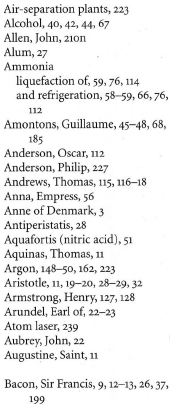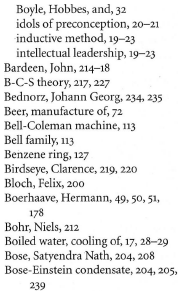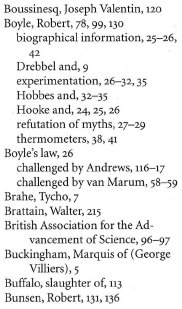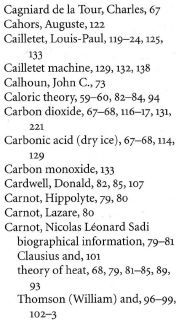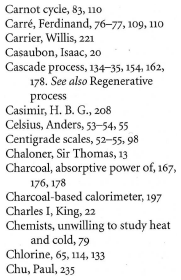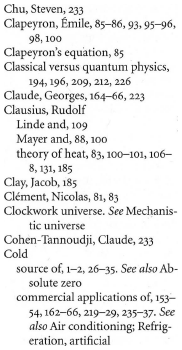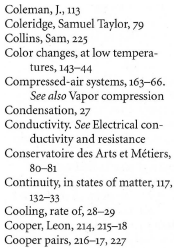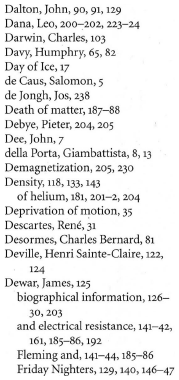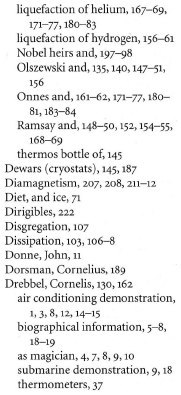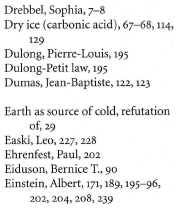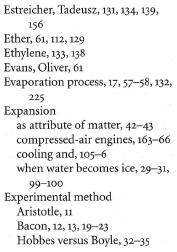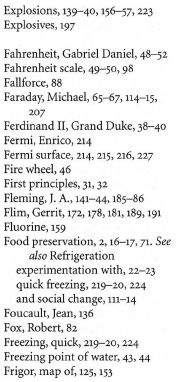Absolute Zero and the Conquest of Cold (34 page)
Read Absolute Zero and the Conquest of Cold Online
Authors: Tom Shachtman

Cailletet's communications to the Académie des Sciences are salted through several volumes of its
Comptes Rendus
and its
Annales de Chimie.
Maurice P. Crosland's
Science Under Control: The French Academy of Sciences, 1795â1914,
1992, is the definitive study of that institution during its most distinguished and influential period. Additional insight is provided by Crosland's
Studies in the Culture of Science in France and Britain Since the Enlightenment,
1995. Gwendy Caroe, who spent her youth living in the Royal Institution, has written the best short book on it,
The Royal Institution, An Informal History,
1985.
The Collected Papers of Sir James Dewar,
in two volumes, 1927, was edited by his wife and several colleagues and includes such matter as newspaper reportage of his speeches where no other written material exists. Important supplements are articles by Agnes M. Clerke and by Henry E. Armstrong in the
Proceedings of the Royal Institution,
1901 and 1909, which analyze the low-temperature research. Armstrong's longer memoir,
James Dewar,
1924, is the most significant source of biographical information. Morris Travers's two books,
The Discovery of the Rare Gases,
1936, and
A Life of Sir William Ramsay,
1956, discuss the Ramsay-Dewar controversies. Tadeusz Estreicher's chapter "The Siamese Twins of Polish Science," referring to Olszewski and von Wrôblewski, is in
Great Men and Women of Poland,
edited by Stephen P. Mizwa, 1942.
Carl Linde's autobiography
Aus Meinem Leber und Meinem Arbeit,
1979, is explicated in Mikael Hard's
Machines Are Frozen Spirit,
1994. Robert J. Soulen wrote about Dewar's flask in
Physics Today,
1996. Some of the Dewar-Onnes correspondence is printed in an English edition of the selected papers of the
Communications from the Physical Laboratory at Leiden,
entitled
Through Measurement to Knowledge,
edited by Kostos Gavroglu and Yorgos Goudaroulis, 1991. More of it exists in manuscript at the Boerhaave Museum in Leiden. Anne C. Helden's pamphlet "The Coldest Spot on Earth," 1989, is a reliable guide to Onnes's procedures. Additional light is shed on Kamerlingh Onnes's contributions by Rudolf de Bruyn Ouboter in various recent articles, and in a chapter of the Gavroglu book. Leo Dana's memoir of his year with Onnes is in
Cryogenic Science and Technology,
edited by R. J. Donnelly and A. W. Francis, 1985. Another good source of biographical information is a memorial lecture by Ernest Cohen in
Journal of the Chemical Society,
1927. The discovery of superfluidity is well covered in an article by Donnelly in
Physics Today,
July 1955.
The work and lives of Pyotr Kapitsa and Lev Landau are best traced, in English, by a translation of Anna Livanova's 1980 memoir
Landau, A Great Physicist and Teacher,
and by such books as
Kapitza: Life and Discoveries,
1984, by F. B. Kedrov, and
Kapitza, Rutherford, and the Kremlin,
1985, by Lawrence Badash.
Chapter 13
In
Frozen Foods: Biography of an Industry,
1963, E. W. Williams tackles the subject with an insider's knowledge, as does a lecture by Clarence Francis of General Foods, "A History of Food and Its Preservation," 1937, which details the work of Clarence Birdseye. Gail Cooper's
Air-Conditioning America: Engineers and the Controlled Environment, 1900â1960,
1998, deals properly with a neglected subject. The growth of the cryogenics industry and of the commercial use of liquefied gases is traced in David Wilson's
Super-cold,
1979. In
Biophysics and Biochemistry at Low Temperatures,
1986, the topic is examined by Felix Franks. The "Woodstock of Physics" era and high-critical-temperature superconductivity are the subjects of a handful of books, the best of them being Bruce Schecter's
The Path of No Resistance,
1989, and Robert M. Hazen's
Breakthrough,
1988. Articles about superconductivity in the decade after the 1987 breakthrough are found in issues of
Scientific American, Science, Physics Today,
and other journals, as well as in the science sections of the
New York Times.
The nexus of low-temperature physics, particle physics, and astronomy is detailed in
Near Zero: New Frontiers of Physics,
edited by J. D. Fairbank, et al., 1988, and especially in William Fairbanks's chapter, "Some Thoughts on Future Frontiers of Physics." Information on commercial work in superconductivity and liquefied gases comes from Web sites of the United States Department of Energy and the various industrial companies involved in these endeavors, and information on recent advances in various fields utilizing low-temperature research is taken from the Web sites of MIT and other universities and from newspaper reports. Contemporary work on cooling techniques for electronic equipment is gleaned from Win Aung's edited compilation for the National Science Foundation,
Cooling Techniques for Computers,
1991;
Thermal Measurements in Electronics Cooling,
edited by Kaveh Azar, 1997; and the proceedings of the American Institute of Physics, Thirteenth International Conference on Thermoelectrics, 1995.

